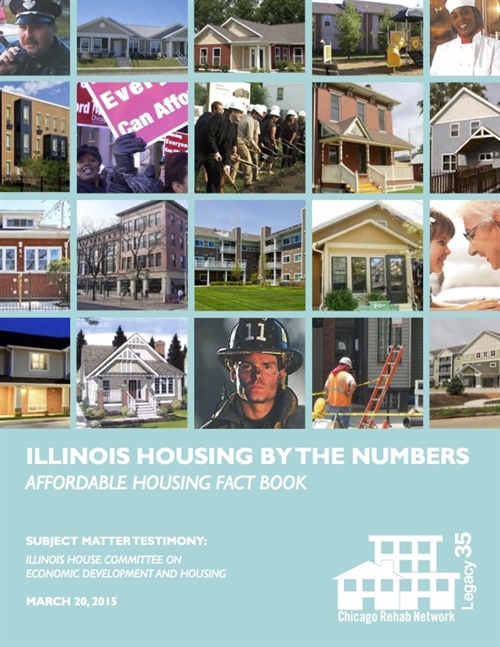Illinois Housing by the Numbers: County Fact Sheets
- March 20, 2015
- Factsheet

Dear Illinois Legislators,
In communities across Illinois—from Champaign to Alton, Chicago to Cairo—the dire need for housing that is a ordable is shaping the geography of opportunity. When families are not secure in their housing, communities su er: children don’t do as well in school, family members experience health setbacks, local businesses lose out on consumer spending, and governments are deprived of tax revenue. To reverse these liabilities and extend the reach of prosperity in Illinois, we must make the provision of a ordable apartments and homes for purchase a policy and resource allocation priority.
To help you understand the magnitude of this issue, the Chicago Rehab Network has prepared A ordable Housing Fact Sheets for all 102 counties in Illinois. This research is part of the third edition of our A ordable Housing Fact Book, an ongoing e ort to provide baseline information about communities across Illinois to inform legislators, advocates, and other stakeholders about housing needs and to bring a ordable housing to the forefront of public discourse.
While the roots of the A ordable Housing Fact Book are in Chicago, we expanded the second edition of the Fact Book statewide in 2003, and are pleased to do so again with the third edition today. This edition of the Fact Book adds even more demographic and quality of life indicators in an e ort to propel a conversation grounded in fact about serious existing and growing needs in our communities.
As I’m sure you know, the situation on the ground today in Illinois is stark. Although Illinois grew moderately from 2000 to 2010, we continued to lose our share of the national population—part of a troubling long-term trend. While much of this population shift is a consequence of larger economic changes in the Midwest and the nation, some still should be attributed to issues of opportunity and quality of life, which have everything to do with community a ordability and stability.
This Fact Book explores changes in Illinois counties from 2000 to 2010, delving into some comparative analysis to show the depth and breadth of the challenges in front of us today. Major ndings include:
- In a state where today the income of the top 1% is thirty times that of the bottom 99% (#8 in the nation for income inequality)1, 76 out of 102 Illinois counties lost median household income between 2000 and 2010. This means that there has been a substantial increase in Illinoisans living on less.
- Despite stagnant or declining incomes for many families and individuals, median rents and mortgages rose for the vast majority of Illinoisans. In 92 out of 102 counties, median rent increased. Statewide, median rent grew over $200 per month. Median mortgages grew even more, increasing in 100 out of 102 Illinois counties. Statewide, the median mortgage increased by over $500 per month.
- Flat incomes combined with rising housing costs have contributed to a dramatic increase in housing insecurity for both owners and renters across Illinois. When housing costs are greater than 30% of available income, those families are said to be “cost burdened” or experiencing “housing insecurity”. Households struggling with housing insecurity experience consequences in all dimensions of nancial wellbeing, including paying for health care and prescriptions, meeting debt obligations, saving for retirement, and purchasing healthy food. They are also more likely to move frequently, more vulnerable to homelessness, and less likely to make some consumer purchases that stimulate the local economy. From 2000 to 2010, housing insecurity increased in the majority of counties for both renters (92 out of 102 counties) and owners (98 out of 102 counties).
- Steep increases in housing insecurity across the board have brought statewide rates to record levels: 1 out of 2 renters and 1 out of 3 owners in Illinois cannot a ord their housing.
Now is the time to act. Housing that is a ordable is the foundation for educational and employment success, community stability and regional competitiveness. With your leadership, we can advance housing policies that help build a more sustainable, prosperous, and equitable Illinois.
Sincerely,
Kevin F. Jackson
Executive Director

